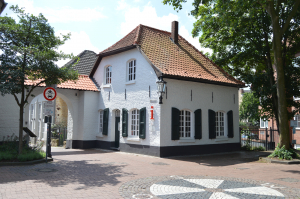Dinslaken
Green gateway to the Ruhr region
The history of the town began around 800 years ago with the construction of a castle and a small settlement in the middle of a marshy area. Dinslaken was granted town rights in 1273, prospered in the 14th/15th century and joined the Hanseatic League under the leadership of Wesel in 1540.
Dinslaken is a cycling town, Fairtrade town, shopping town, sports and cultural centre, characterised by medium-sized companies in the midst of a beautiful landscape – a green gateway to the Ruhr region and gateway to the Lower Rhine.
MOVE between history and history (old town, historic town hall, water mill, windmill, castle theatre) as well as change and modernity (structural change Lohberg colliery, new Kathrin-Türks-Halle, shopping mile between Neutor and Altmarkt, the modern indoor swimming pool DINamare, ice rink and ultra-modern district sports facilities).
EXPERIENCE nature and culture on the border with the Lower Rhine and the Hohe Mark Nature Park, on the Emscher Trail and along the Rhine with its wide floodplains and along the Rotbach Trail. Around the new Emscher estuary, a place of local recreation is being created where people can enjoy nature or simply relax. The former farmstead is not only an informative centre for the conversion of the Emscher, it also serves as a place to stop for refreshments, informal learning, experiencing and learning about ecological relationships.
Immerse yourself in the world of art, culture or poetry at one of our cultural events in our Kathrin-Türks-Halle, in the Burgtheater, in the Zechenwerkstatt, at the events in the districts or in the city centre. At the FANTASTIVAL and Summer Culture, you can experience a top-class cultural and musical programme on cosy summer evenings in our Burgtheater between the Altmarkt and the historic castle.
Come along and enjoy the diversity of Dinslaken!
Place of interest
Click here for more information
Museum Voswinckelshof
The Voswinckelshof City History Museum is housed in a former three-winged aristocratic residence from the 17th century in the centre of Dinslaken’s old town.
Dinslaken Castle with castle theatre
The listed castle is located in the centre of Dinslaken’s town park. The original three-winged complex was first mentioned in documents in 1163. After being almost completely destroyed in 1945, the castle was rebuilt in a modern style and now houses parts of the current town hall.
The open-air theatre was planned and completed in 1934. In the summer months, numerous musical and cultural events from concerts and cabaret to theatre attract a wide audience. The FANTASTIVAL Dinslaken, a large open-air festival that is known far beyond the city limits, has become firmly established. The Burgtheater creates a very special atmosphere for around 1,800 visitors.
Gatehouse and knight’s gate
The knight’s gate with the former gatehouse forms the entrance to the old town centre. The whitewashed brick building is one of the oldest houses in Dinslaken and is therefore a visible historical landmark. The knight’s gate and gatehouse once separated Dinslaken Castle from today’s old town centre. It is the only surviving gate of the five former city gates of Dinslaken. Today, the city information centre of Dinslaken is located in the gatehouse.
Emscher estuary
The Emscher travels around 80 kilometres from its source in Holzwickede until it flows into the Rhine in Dinslaken. After eight years of construction, the Emschergenossenschaft has created a delta of around 20 hectares by relocating the river to the north, which will not only offer improved flood protection in future. For flora and fauna, it forms an important gateway from the Rhine and the new Emscher valley.
The idyllic Emschermündung farm is located directly at the mouth of the Emscher. It offers a wide range of activities for young and old. The café invites cyclists and walkers to linger, while children can let off steam in the playground (including a barefoot path).
The numerous offers on the farm are based on the 17 global goals for sustainable development of the Agenda 2030 adopted by the United Nations (UN). The farm also serves as a place for informal learning, experiencing and learning about ecological connections.
Lohberg garden city and former colliery site
Planned in 1907 along the lines of English garden cities, Lohberg was regarded as Europe’s most modern colliery site: living, working and doing business in a healthy natural environment and with the latest technology of the time.
Since then, the history of the Ruhr region has been directly tangible in Lohberg: The Ruhr War, coal barons, the economic miracle, the glamour and decline of mining, immigration and cultural diversity have all left their mark on the garden city and left visible traces. Today, the pretty colliery housing estate is a listed building. The Ledigenheim is a generously renovated centre for culture, services and commerce. The market on Johannesplatz attracts customers from all over the region twice a week. Life in the neighbourhood is colourful, lively and worth living in. The colliery was closed at the turn of the year 2005 / 2006.
Hiesfeld
The idyllic mill village is the largest district of Dinslaken. Hiesfeld stands for a cosy village atmosphere with lively shopping streets, a large market square, lots of culture and nature. In addition to a leisurely stroll through the attractive shops, the windmill and water mill are also worth a visit. The Rotbachsee lake and the valley of the same name invite you to go horse riding, cycling or walking.
photo gallery
Contact
Stadtinformation am Rittertor
Ritterstraße 1
46535 Dinslaken
Telefon: 02064 – 66 222



























